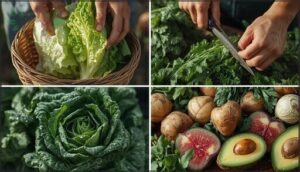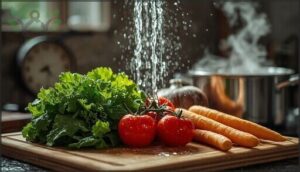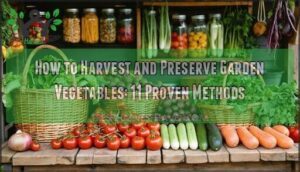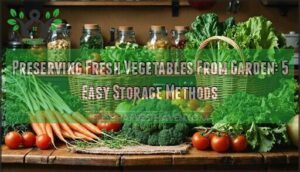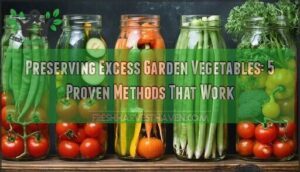This site is supported by our readers. We may earn a commission, at no cost to you, if you purchase through links.
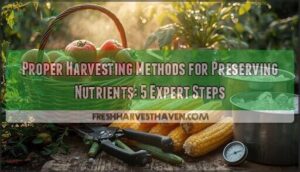
Pick produce at ideal ripeness – tomatoes should yield slightly to pressure, corn kernels should release milky juice, and peppers need glossy, firm skin.
Use sanitized tools and gentle handling to prevent bruising, which destroys up to 20% of vitamins.
Sort your harvest immediately into groups for quick use, short-term storage, or long-term preservation.
Cool produce rapidly after picking to lock in 30% more vitamins and minerals.
Proper harvesting methods for preserving nutrients start with timing, but the real magic happens in what you do next.
Table Of Contents
- Key Takeaways
- Key Principles of Nutrient-Preserving Harvesting
- Minimizing Nutrient Loss During Harvest
- Optimal Post-Harvest Storage Strategies
- Best Preservation Methods for Nutrient Retention
- Maximizing Nutrition From Garden to Table
- Frequently Asked Questions (FAQs)
- How do you keep food fresh for a harvest?
- How do you maintain quality during harvesting?
- Does food preservation improve nutrient profile?
- How do you keep produce safe during harvesting?
- What should I do after harvesting my produce?
- How do you store dried produce after harvesting?
- What are the methods of preserving nutrients?
- What is the proper method to harvest the plants?
- What are the methods of prevention of nutrients?
- What is the best method for preserving nutrients in vegetables?
- Conclusion
Key Takeaways
- Harvest in early morning – You’ll retain 15% more vitamin C when you pick produce before dawn, while plants are fully hydrated and temperatures are cool.
- Handle gently with clean tools – You’ll prevent up to 20% vitamin loss by using sanitized equipment and avoiding bruising through careful handling techniques.
- Cool rapidly after picking – You’ll lock in 30% more vitamins and minerals by immediately moving harvested produce to cool storage conditions.
- Sort and store properly – You’ll maximize nutrient retention by immediately grouping produce for immediate use, short-term storage, or long-term preservation based on each crop’s specific needs.
Key Principles of Nutrient-Preserving Harvesting
When you harvest your garden produce, timing and technique directly impact nutritional value.
Research shows that harvesting leafy greens in the early morning retains up to 15% more vitamin C compared to midday collection, while gentle handling prevents the 20% vitamin E loss that occurs from bruising fruits.
Timing your harvest right locks in 15% more vitamin C than waiting until noon
Best Time of Day to Harvest
Before dawn breaks, morning harvest delivers your garden’s peak nutritional punch.
Fresh produce handling during daily cycles maximizes nutrient preservation when plants are fully hydrated and vitamin levels soar.
Optimal harvest timing includes:
- Early morning hours – Leafy greens retain 15% more vitamin C than midday collection
- Cool temperatures – Prevent rapid nutrient degradation from heat stress
- High plant moisture – Guarantees maximum freshness and nutrient density
- Pre-sunrise window – Captures peak ripeness before daylight impact reduces quality
This food harvesting technique locks in healthy food harvesting benefits through strategic timing.
Identifying Peak Ripeness
Peak ripeness indicators vary by crop but share common visual and tactile cues.
Look for vibrant color changes, firm-yet-yielding texture, and natural sugar development.
Tomatoes show deep red coloring, while corn kernels release milky juice when pressed.
These ripeness signs guarantee maximum nutrient content through proper harvest timing and organic farming methods.
| Crop Type | Key Ripeness Signs | Texture Check Method |
|---|---|---|
| Tomatoes | Deep red color, slight give | Gentle squeeze test |
| Corn | Plump kernels, brown silks | Press kernel for milky juice |
| Peppers | Full color, glossy skin | Firm walls, crisp snap |
Harvest timing directly impacts sugar content and nutrient preservation.
Fresh produce handling starts with recognizing when vegetables reach their nutritional peak, supporting both food harvesting techniques and proper food storage practices.
Clean and Gentle Handling Techniques
Once you’ve identified peak ripeness, proper handling techniques prevent unnecessary nutrient loss through physical damage.
Your approach to harvest matters as much as timing.
Here are 5 clean and gentle handling techniques for whole food harvesting:
- Use sanitized tools – Clean cutting shears and knives with rubbing alcohol prevent pathogen introduction that accelerates spoilage and nutrient degradation.
- Practice gentle cutting – Make clean cuts rather than twisting or pulling, which reduces oxidative damage and preserves up to 15% more vitamin C in herbs.
- Maintain clean equipment – Wash harvest baskets and containers between uses to eliminate bacteria that compromise food quality during organic farming methods.
- Apply minimal handling – Limit touching produce to reduce bruising that can decrease vitamin E content by 20% in fruits.
- Employ soft sorting – Place delicate items like berries and leafy greens in shallow containers to prevent crushing during proper food storage preparation.
These food harvesting techniques safeguard nutrient retention from garden to table while maintaining produce quality.
Grouping Produce for Storage or Use
After gentle handling, you’ll want to sort your harvest into three main categories for maximum nutrient retention.
This produce sorting system maximizes freshness ranking while supporting sustainable agriculture practices.
| Storage Group | Purpose |
|---|---|
| Immediate Use | Peak nutrition consumption |
| Short-term Storage | 1-7 day freshness |
| Long-term Preservation | Processing/canning prep |
| Compost Grade | Overripe/damaged items |
| Seed Saving | Future crop propagation |
Smart harvest classification prevents nutrient loss through proper crop segregation.
Your locally sourced produce deserves this systematic approach to maintain whole food harvesting benefits throughout seasonal food production cycles.
Minimizing Nutrient Loss During Harvest
Every step you take during harvest directly impacts the nutrients that remain in your produce.
You’ll preserve up to 30% more vitamins and minerals by following proper techniques that prevent cellular damage and oxidation.
Preventing Bruising and Physical Damage
Physical damage cuts nutrient levels fast. Handle produce like you’re carrying eggs – gentle movements prevent bruising that destroys up to 20% of vitamin content.
Treat your harvest like precious cargo—every bruise steals nutrients from your table
Use two hands for heavy items and avoid drops entirely. Sharp, clean cuts beat rough tears every time.
Cushioned containers and proper harvest timing during warmer temperatures keep your sustainable agriculture efforts intact through careful physical protection and damage reduction.
To minimize damage, understanding bruise prevention methods is essential for maintaining nutrient levels and ensuring proper harvest.
Using Sanitized Tools and Equipment
Clean tools prevent contamination that compromises nutrient stability during harvest.
Sanitized equipment creates an invisible barrier against pathogens that can accelerate nutrient degradation and spoilage.
Essential sterilization methods for tool maintenance:
- Alcohol wipes – Quick disinfection between crops during harvest sessions
- Bleach solution – Deep cleaning for cutting tools and harvest containers
- Heat sterilization – Steam cleaning for reusable equipment before storage
- UV sanitizers – Chemical-free option for small hand tools and pruners
- Antimicrobial sprays – Field-ready solutions for immediate tool hygiene
Using proper sanitized tool practices is vital for maintaining hygiene.
This approach supports regenerative agriculture principles while ensuring natural food production maintains maximum nutritional value through proper hygiene practices.
Reducing Moisture and Pathogen Exposure
Keep your freshly picked produce dry – wet surfaces boost decay rates by 50%.
Harvest during dry conditions and avoid rain or dew, which increases spoilage risks by 30%.
Proper airflow through storage containers reduces mold formation by 60%.
Move crops to clean, ventilated areas immediately after picking to prevent pathogen exposure and maintain nutritional quality.
This approach aligns with organic harvesting practices that prioritize soil health.
Immediate Post-Harvest Steps
After protecting produce from moisture and pathogens, act swiftly with proper immediate cooling techniques.
Sort your harvest into groups: immediate use, short-term storage, and long-term preservation. This sorting process follows dictionary definitions of food processing methods in english language usage.
Practice gentle handling throughout sorting to prevent bruising. Maintain tool sanitation between different produce types.
Remember this key dictionary reference: delay washing until you’re ready to use items, as moisture accelerates spoilage.
Optimal Post-Harvest Storage Strategies
Once you’ve harvested your produce with care, proper storage becomes critical for maintaining those hard-earned nutrients.
Your storage strategy directly impacts how long vegetables retain their vitamins, minerals, and flavor—with the right conditions preserving up to 30% more nutrients compared to improper storage methods.
Temperature and Humidity Control
Proper cooling techniques after harvest preserve up to 30% more ascorbic acid in leafy vegetables.
Rapid cooling to 0-4°C slows nutrient degradation, maintaining folate levels for weeks.
High humidity levels prevent 16% vitamin B2 losses in spinach.
Controlled-atmosphere storage with ideal conditions reduces vitamin A loss by 19% in carrots, extending storage duration substantially.
To guarantee maximal longevity, consider root cellar conditions for crops like carrots and potatoes.
Ethylene Gas Management
Ethylene sensors and gas monitoring systems help you track ripening triggers that accelerate nutrient loss.
This invisible gas speeds up respiratory rate in produce, breaking down vitamins and antioxidants.
Smart storage atmosphere control protects your harvest investment.
Effective ethylene management strategies are vital for preserving nutrients.
Essential ethylene management strategies:
- Separate producers from sensitive crops – Keep apples away from leafy greens to prevent premature aging
- Install ventilation systems – Fresh air circulation removes accumulated ethylene gas naturally
- Use ethylene scrubbers – Activated carbon filters absorb excess gas, extending shelf life substantially
Storage Methods for Different Produce Types
Different produce types require customized storage approaches to maintain nutrient levels and prevent spoilage.
You’ll need to match each vegetable or fruit with its ideal environment, considering factors like temperature, humidity, and air circulation for best results.
| Storage Type | Best For | Conditions |
|---|---|---|
| Root Cellars | Potatoes, carrots, beets | 32-40°F, 85-95% humidity |
| Cool Storage | Apples, cabbage, onions | 32-35°F, 60-70% humidity |
| Dry Rooms | Winter squash, garlic | 50-55°F, 50-60% humidity |
| Ethylene Control | Leafy greens, broccoli | Separate from ethylene producers |
Your holistic farming practices pay off when you understand that chemical free farming extends beyond growth into proper storage techniques.
Rapid Cooling and Controlled Atmospheres
Once you’ve sorted your produce by type, time to lock in those nutrients through rapid cooling. Think of it like hitting the pause button on nutrient loss—every minute counts.
Cold storage combined with controlled atmospheres creates the perfect environment to maintain peak nutrition levels.
- Rapid Cooling: Drop produce temperature to 32-35°F within hours of harvest using ice baths or refrigerated air to retain up to 30% more ascorbic acid
- Temperature Management: Maintain consistent cold storage at 0-4°C to slow nutrient degradation and preserve folate levels for 1-2 weeks
- Humidity Regulation: Control moisture levels at 85-95% relative humidity to prevent 16% vitamin B2 losses in leafy greens
- Atmosphere Control: Use oxygen-free storage bags or controlled-atmosphere environments to maintain 25% more lycopene in tomatoes and reduce vitamin A loss by 19% in root vegetables
Best Preservation Methods for Nutrient Retention
You’ll maximize your harvest’s nutritional value by choosing the right preservation method for each type of produce.
Different techniques like blanching, freezing, dehydrating, and fermentation each preserve specific nutrients while breaking down others, so matching the method to your food type guarantees you retain the most vitamins and minerals possible.
Blanching and Freezing Techniques
Blanching vegetables in boiling water for 1.5-5 minutes deactivates enzymes that destroy nutrients during storage.
This thermal shock process retains up to 88% of vitamin C when done precisely.
Flash freezing creates smaller ice crystals, preserving texture better than slow freezing.
Proper consultation on blanching times prevents overblanching, which increases nutrient losses.
Immediate ice water cooling halts cooking and maintains quality.
Effective use of blanching equipment is essential for achieving superior results in the preservation process, ensuring the best possible outcome with proper consultation.
Dehydrating and Freeze-Drying
Two preservation methods maximize nutrient stability through moisture removal.
Dehydrating removes water slowly, preserving vitamins and minerals while creating lightweight, shelf-stable foods perfect for dry storage.
Freeze dryers use sublimation to transform frozen water into vapor, maintaining cellular structure and nutritional content better than traditional dehydration methods.
Both food preservation techniques support eco friendly farming by reducing waste and extending harvest usefulness, which ultimately contributes to a more sustainable approach.
Canning, Pickling, and Fermentation
Canning methods preserve most nutrients while boosting bioavailable lycopene in tomatoes by over 50%.
Pickling tips include maintaining pH below 4.6 for food safety and nutrient preservation.
The fermentation process increases protein content and reduces anti-nutritional compounds, improving mineral absorption.
These techniques require proper care with sanitized equipment for eco friendly farming practices that support soil conservation.
Choosing Methods Based on Food Type
When selecting preservation methods, you’ll want to match techniques to your specific crops.
High-acid foods like tomatoes work well with water bath canning, while low-acid vegetables need pressure canning for safety.
Leafy greens retain nutrients best through blanching and freezing.
Root vegetables store well fresh in cool conditions.
Consider nutrient testing to guide your storage solutions and harvest timing decisions.
Understanding proper food preservation methods is essential for maintaining nutrient retention and overall food quality.
Maximizing Nutrition From Garden to Table
Once you’ve harvested your produce, the race against nutrient loss begins immediately.
You’ll preserve the most vitamins and minerals by minimizing the time between picking and eating, using gentle washing techniques, and choosing cooking methods that protect rather than destroy essential nutrients, which includes minimizing the time and using gentle washing techniques.
Minimizing Time From Harvest to Consumption
Time acts as nutrition’s enemy after harvest timing determines peak freshness.
Nutrient decay begins immediately when crops leave their roots, making rapid cooling and fresh handling essential.
Smart consumption strategies include eating within hours of picking or processing immediately.
Environmentally friendly farming with proper crop rotation supports this goal by staggering harvests for continuous fresh supply, ensuring fresh handling and proper crop rotation.
Washing and Preparing for Maximum Nutrient Retention
Gentle washing preserves water-soluble vitamins that leak easily during food preparation.
Rinse vegetables quickly under cool running water without soaking to maintain vitamin C and B-complex nutrients.
Pat dry immediately after washing to prevent nutrient loss through extended moisture exposure.
Use clean hands and sanitized surfaces for safe crop handling.
Test soil nutrients annually to optimize harvest timing and guarantee proper plant nutrition from garden to table.
Understanding proper vegetable storage methods is vital for maintaining freshness and nutritional value.
Cooking Methods to Preserve Nutrients
Once you’ve prepped your vegetables properly, cooking them right makes all the difference.
Smart cooking preserves nutrients while enhancing flavors:
- Steaming Techniques retain 85-95% of vitamin C by using indirect heat
- Microwaving keeps 90-98% of vitamins with quick 2-5 minute cooking times
- Stir Frying preserves carotenoids better than deep frying when done fast
Choose your method based on the vegetable and desired outcome.
Balancing Fresh, Frozen, and Preserved Options
You don’t have to choose just one option.
Fresh produce delivers peak nutrients when eaten within hours of harvest. Frozen alternatives retain similar nutrient levels through proper blanching techniques.
Preservation methods like dehydrating maintain specific vitamins while extending shelf life.
Smart storage solutions let you enjoy nutrient-rich foods year-round using different approaches for ideal results.
Frequently Asked Questions (FAQs)
How do you keep food fresh for a harvest?
Harvest early morning when vegetables are most hydrated.
Use clean, sanitized tools to prevent contamination. Handle produce gently to avoid bruising, which reduces nutrient content.
Cool harvested crops immediately to retain vitamins and slow degradation, ensuring the produce remains in the best condition possible by following these complete concepts.
How do you maintain quality during harvesting?
Like golden threads weaving through morning dew, your careful hands preserve nature’s bounty.
Use sanitized tools, harvest when cool and hydrated, handle gently to prevent bruising.
And cool quickly to lock in vitamins and freshness.
Does food preservation improve nutrient profile?
Food preservation doesn’t improve your produce’s nutrient profile—it actually reduces nutrients through processing.
However, freezing and proper storage can retain 80-90% of original vitamins, making preserved foods nutritionally viable when fresh isn’t available.
How do you keep produce safe during harvesting?
While speed matters during busy harvest times, you’ll protect your produce by using clean, sanitized tools and handling everything gently to prevent bruising and contamination that leads to spoilage.
What should I do after harvesting my produce?
After harvesting, you’ll want to handle your produce with care to lock in those nutrients.
Sort your harvest immediately – separate what you’ll eat fresh, store, or compost.
Keep everything cool and avoid washing until you’re ready to use it, since moisture invites spoilage.
How do you store dried produce after harvesting?
Store dried produce in airtight containers away from light and heat.
Dark, cool pantries work best—think basement temperatures around 60°F.
Glass jars or vacuum-sealed bags prevent moisture reabsorption, keeping your hard work crisp.
What are the methods of preserving nutrients?
You’ll preserve nutrients through proper timing, gentle handling, and smart storage.
Harvest early morning when produce is most hydrated, use clean tools, avoid bruising, cool rapidly after picking.
Choose appropriate preservation methods like blanching before freezing or controlled-atmosphere storage.
What is the proper method to harvest the plants?
Use clean, sanitized tools and harvest in early morning when plants are most hydrated. Handle produce gently to prevent bruising, which reduces nutrient content by up to 20% in fruits.
What are the methods of prevention of nutrients?
Like a shield protecting precious cargo, nutrient prevention requires swift action after harvest.
You’ll preserve nutrients through rapid cooling, proper storage conditions, gentle handling, minimizing processing time, and choosing appropriate preservation methods.
Like blanching before freezing or controlled-atmosphere storage, these methods help maintain the quality of the cargo.
What is the best method for preserving nutrients in vegetables?
Harvest vegetables in early morning when they’re freshest and most hydrated.
Handle gently to avoid bruising, which reduces nutrients.
Use rapid cooling post-harvest to retain vitamins, then store properly based on each vegetable’s specific needs to ensure they remain fresh and nutritious with proper handling.
Conclusion
Like a tree’s final harvest before winter’s sleep, your garden’s bounty reaches peak nutrition only when you follow proper harvesting methods for preserving nutrients.
These five expert steps—timing, ripeness recognition, gentle handling, immediate sorting, and rapid cooling—create a protective shield around your produce’s essential compounds.
You’ve transformed from casual gardener to nutrition guardian, ensuring every vegetable and fruit delivers maximum health benefits.
Your careful attention to proper harvesting methods for preserving nutrients means each bite nourishes your body with nature’s full potential, and by doing so, you ensure that your garden’s produce is handled with gentle handling to preserve its quality.

